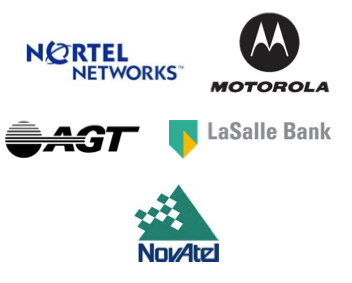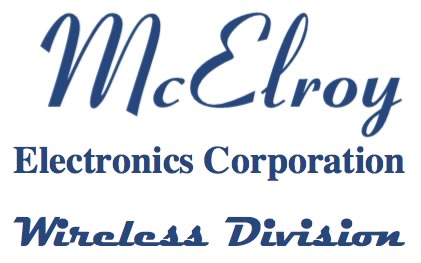
Cellular Telephone Systems and Licenses
 In the 1970s, the Federal Communications Commission (FCC) questioned whether the American Telephone & Telegraph Company (AT&T) was using monopoly profits from its Western Electric subsidiary to subsidize the costs of its network, which was contrary to U.S. antitrust law.
In the 1970s, the Federal Communications Commission (FCC) questioned whether the American Telephone & Telegraph Company (AT&T) was using monopoly profits from its Western Electric subsidiary to subsidize the costs of its network, which was contrary to U.S. antitrust law.
This resulted in a 1976 suit brought by the Justice Department against AT&T.
It was settled in 1982 by a consent decree between AT&T and the Federal Trade Commission (FTC) that provided for the breakup of the Bell System and resulted in creation of 7 independent companies that were formed from the original 22 AT&T–controlled members of the System. They became known as the “Baby Bells.”
At the time of the breakup, these companies (referred to as RBOCs, i.e., Regional Bell Operating Companies) were
- Ameritech, acquired by SBC in 1999, now part of AT&T Inc.
- Bell Atlantic, acquired GTE in 2000 to form Verizon Communications
- BellSouth, acquired by AT&T Inc. in 2006
- NYNEX, acquired by Bell Atlantic in 1996, now part of Verizon Communications
- Pacific Telesis, acquired by SBC in 1997, now part of AT&T Inc.
- Southwestern Bell (later SBC, now AT&T Inc.), which acquired AT&T Corp. in 2005
- US West, acquired by Qwest in 2000, which in turn was acquired by Century Link in 2011
Not only had this breakup caused the creation of local Bell Operating Companies, but it also opened up the lucrative industry of cellular wireless communication to entrepreneurs.
This breakup was reminiscent of the 1911 breakup of one of the world’s first and largest multinational corporations, Standard Oil Co. Inc. The world’s largest oil refiner at the time, it was deemed an illegal monopoly by the US Supreme Court.
After the AT&T breakup, the FCC, seeking to make wireless communication ubiquitous in the United States, opened the doors for entrepreneurs to file for cellular telephone licenses.
And as it turned out, the early days of the cellular telephone industry had all the earmarks of the California gold rush of the mid-19th century or the rush for control of the oil market in the late 19th and early 20th centuries, replete with colorful characters, massive returns on investment, cycles of boom and bust, and displays of entrepreneurship. James B. Murray, Jr. wrote the definitive work on this subject, entitled Wireless Nation: The Frenzied Launch of the Cellular Revolution in America, published in 2001.
An Opportunity for McElroy
In late 1985 McElroy Electronics took advantage of this huge opportunity. I knew well the value of an FCC license, having been an account executive at Westinghouse Broadcasting’s WBZ Radio 1030 in Boston, MA.
 We entered into a contract with an engineering firm to purchase applications to serve various Metropolitan Statistical Areas (MSA) with populations of approximately 200,000–250,000.
We entered into a contract with an engineering firm to purchase applications to serve various Metropolitan Statistical Areas (MSA) with populations of approximately 200,000–250,000.
Faced with technical changes in the electrical component industry, we sought to diversify our business by entering the field of cellular telephone communications––an industry still in its infancy.
We contracted with an engineering firm to submit applications to the Federal Communications Commission which would provide cellular telephone service to various Metropolitan Statistical Areas (MSA) with populations of approximately 200,000–250,000.
In May 1986, the Federal Communications Commission selected McElroy Electronics to be the Cellular Licensee to begin offering cellular telephone service to market #151, Poughkeepsie, New York.
Because of the nature of the undertaking, McElroy Electronics owned the controlling interest in the market. The start-up entity we formed was duly named Dutchess County Cellular Telephone Company, Inc. Our customers in Poughkeepsie NY, knew us as…

Copy of our FCC license to serve the Poughkeepsie, NY, market
My brother Mark joined McElroy Electronics Corporation in 1986 to serve as Vice President and General Manager of our new Cellular business division. Together we built out this business and successfully operated it until 1989, when we transferred control to United States Cellular a Chicago based corporation.
McElroy Electronics Corporation––
Pioneering the “Unserved Area” Applications
Based on meetings and discussions with the new district manager, Peter MacDonald in Poughkeepsie, New York, we learned that each cellular provider had 5 years to show complete cellular geographic service area coverage (CGSA) in its filings to the Federal Communications Commission.
However, after the five year period, we realized that, McElroy could petition the FCC for a Cellular telephone license to provide cell service coverage to those geographic areas which were absent of cell service Those applications became known as “Fill-ins” and later as “Unserved Area Applications”
After a final visit to our Poughkeepsie Office, saying goodbye to the management team, we handed over the keys to the new owners. Time was of the essence. My brother Dan and I flew to Washington DC to meet with our Attorneys to investigate this new opportunity. On the same day, around 5pm, we were in the FCC Wireless Division looking at the CGSA maps of the cellular carriers in the major markets. It was not long before we discovered unserved areas in those markets.
The following day, we flew back to our offices in Shirley, Massachusetts, and conducted a thorough study of all the build-out deadline dates in the top 40 markets in the country.
We found that the Los Angeles MSA, (second largest market in the country), had a significant land area that was unserved at the end of the 5-year deadline. We engaged our engineering team and gave them the responsibility of designing and preparing a system of towers and radio transmitters to serve the area. It took about 6 months to complete the market analysis, engineering and legal work to prepare and file an application so completed that we could file an application with the FCC to serve the LA Market..
This was a pioneering endeavor, which had never been done before. It raised a lot of eyebrows and gave us notoriety among FCC staffers, engineers and division chiefs. Not to mention so many attorneys who practiced communications law. And it turned out to be an interesting and life-changing accomplishment, with accolades to follow.
Here’s the story…
The Los Angeles Application
McElroy was the first applicant in the country to file an “on time” application to serve an unserved area when we filed for an unserved portion of market #2B, Los Angeles, on August 2, 1988.
A lot of time, research, and money went into preparing for this filing. We had no sure model to follow. Our early research showed that Santa Catalina Island would meet the criteria (like the song says, “Twenty-six miles across the sea, Santa Catalina is a-waitin’ for me”).
Unfortunately, when the deadline came, the licensee had covered the area.
Disappointed but undaunted, we pushed ahead.
In our initial application we proposed to serve nearly 100,000 people and over 80 miles of interstate highway that had been neglected by Pacific Telesis in the Los Angeles market. Our application was accepted by the FCC and placed on public notice on August 29, 1988.
In October 1988 we met with the top staff members, division chiefs, and lawyers of the FCC to discuss an early grant since no competing applications were found on file. (In most cases, a grant would not be made until 60 days after an application was filed but the rules provided that it was possible to do so in 30 days if the Commission so decided). The Commission staff declined our request for an early grant.
After our LA application was filed, five other Cellular telephone companies (including the incumbent licensee, Pacific Telesis) all of whom copied our first filed application, and then submitted competing applications. It was now October 31st, 1988.
The Federal Communications Commission processed these applications accordingly. And on December 23, 1988, issued a public notice indicating that McElroy Electronics and five other applicants were to be considered for the License..
McElroy’s initial 1988 5-Cell System proposal to serve the unserved area of the
Los Angeles market, covering portions of Interstate 10 up to the Arizona border
After six years, many meetings, and huge lawyer and engineering bills, McElroy and the other parties entered into a full market settlement. By this time, the area of coverage expanded significantly by including Interstate 15 from Barstow CA to the Nevada border.
The May 4, 1994 Unserved Area Settlement Agreement settlement agreement called for the creation of a new entity, representing the three remaining applicants by the name of Desert Telecommunications Limited Partnership in which we were a limited partner.
As illustrated, on the map, the 1994 Settlement Agreement caused the service area to be expanded by hundreds of miles.
Expanded area of coverage due to the 1994 Settlement Agreement I among: McElroy Electronics Corporation,
JAJ Cellular Incorporated, and the incumbent, Los Angeles SMS a Limited Partnership
After filing to serve the LA market, we followed up with other applications quickly. One of the first unserved markets we filed for was a portion of our home market…
Boston, Massachusetts
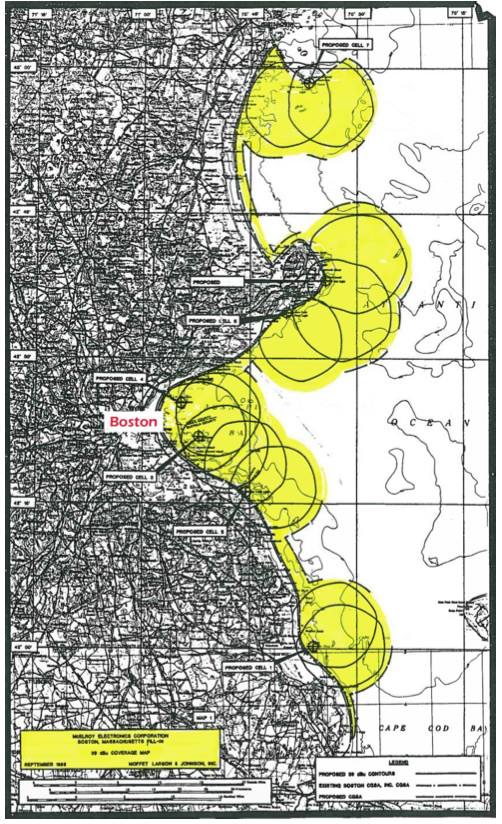 The Boston Market Cellular Telephone licensee was our local phone company, NYNEX. They had defined the eastern border of their Cellular Geographic Service Area (CGSA) by drawing a line right off the coast. They left unserved an area from Isle of Shoals, NH, down south through a portion of Nahant, MA, as well as most of Massachusetts Bay.
The Boston Market Cellular Telephone licensee was our local phone company, NYNEX. They had defined the eastern border of their Cellular Geographic Service Area (CGSA) by drawing a line right off the coast. They left unserved an area from Isle of Shoals, NH, down south through a portion of Nahant, MA, as well as most of Massachusetts Bay.
We saw this as an opportunity to serve marine communication traffic in the area. So we commissioned a market study of the substantial boat traffic in these areas and lined up financing to do the project.
We proposed to serve the coastal areas using lighthouse sites for cellular towers.
We even investigated the possibility of moving an offshore oil platform from the Gulf of Mexico and situating it in Massachusetts Bay to be used as a communications platform.
Light House Cell Sites
We had a series of conversations with the US Coast Guard, who had jurisdiction over lighthouses at the time, and obtained “Reasonable Assurance” letters from them to use the lighthouses as locations for our proposed service antennas and equipment.
No one had ever proposed or thought of using lighthouses as cell sites before. We planned to use 5 lighthouses from southern New Hampshire down to Plymouth, MA.
After commissioning a demand study of marine traffic and doing a thorough engineering evaluation, we submitted our application to serve the unserved area of market #6A, Boston, to the FCC on January 11, 1989.

Boston Light: One of the 5 lighthouses we proposed to use
to provide service to the Massachusetts Bay area.
Our filing had the effect of restricting Nynex’s ability to serve their CGSA. In essence, we pinned them in.
A mountain of petitions was presented to the FCC from both McElroy & Nynex arguing our respective cases.
Nynex argued that the MSA boundary was the “high water” mark . We appealed to Admiralty Las and proved through a Supreme Court decision that the the MSA boundry was realy the Bay Closing Line.
We eventually negotiated a settlement with NYNEX in December 1991 and withdrew our application, which allowed them to expand their CGSA into the Massachusetts Bay area. We used the proceeds to further prosecute our other applications.
Minneapolis–Saint Paul, Minnesota
Craig McCaw founded McCaw Cellular Communications, Inc., in 1987. It is now legally known as New Cingular Wireless Services, Inc., formerly part of AT&T Corporation based in Redmond, WA, owned and operated on the A side of the Minneapolis–St. Paul market.
Proposed coverage for the Minneapolis–St. Paul market
A close examination of its coverage map showed that McCaw had left unserved areas outside the core Minneapolis–St. Paul market that extended to the borders of its Metropolitan Statistical Area (MSA).
We designed the system that would serve those unserved areas. It was quite extensive, as you can see by the map. It was almost as if McCaw had the donut hole and we proposed to serve the rest of the donut.
We submitted our application to serve the unserved area of market #15A, Minneapolis–Saint Paul, to the FCC on January 11, 1989.
“So you guys are the Pirates?”
Dan and I had occasion to meet Craig McCaw at a DC Bar Association luncheon where he was a speaker. We introduced ourselves to him and told him of our filing in Minneapolis. We didn’t know what to expect. After all, we had laid claim to a valuable area in a major market that his firm should have acquired.
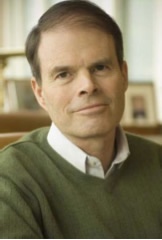
Craig McCaw, founder of McCaw
Cellular Communications, Inc.
To our surprise, he smiled and said, “So you guys are the pirates?” It was gratifying that he recognized the spirit of entrepreneurship in us.
He wasn’t angry, nor should he have been. At the end of the day, we may have been a potential candidate for acquisition. It never happened, though. His firm was acquired by AT&T for $12 billion and we just ended up getting into some nasty fights with AT&T as they deliberately used their vast resources to drive us out of business and bury us.
This was truly a case of David vs. Goliath or the 100 pound gorilla as many in the industry refer to AT&T. But the Lord was on our side.
At the time, AT&T had a slogan you may remember: “Reach out and touch someone.” We used to joke that in our case it was “Reach out and crush someone.”
Eventually, through years of litigation with the FCC, Two court Decisions and the filing of a writ of Mandamus, we were finally granted an exclusive license to serve the Minneapolis market, from the Federal Communications Commission
We established a new entity called Minneapolis Cellular Telephone Company LLC, under which we built and operated the Minneapolis market.
We eventually sold it to Hickory Tech, a local telephone company from Mankato, MN, in June 1999.
Phoenix, Arizona
In Phoenix we proposed to serve areas of Interstate 10 that were unserved from the border to the Phoenix metro area and several surrounding sections of that market.
The area was left unserved by Metro Mobile CTS, the non-wireline carrier in the market.
We submitted our application to serve the unserved area of market #21B, Phoenix, to the FCC on January 17, 1989.
Eventually, Metro Mobile would be bought out by Bell Atlantic and we would end up settling with them.

Proposed coverage of the unserved area in the Phoenix market
We thought long and hard before we filed our application to serve this unserved area of the Phoenix market. That’s because Metro Mobile was owned by George Lindemann, who had a reputation for being difficult to deal with.
We knew that Lindemann was represented by the DC law firm Fleishman Walsh. During our negotiations we found them to be cold, calloused, and with an attitude to match. But we did it anyway.
Lindemann developed Permalens, the first permanent soft contact lens, and sold the operation for $60 million in 1971. He founded Vision Cable in 1972 and sold it for $220 million a decade later. He founded Metro Mobile in 1981 and sold it to Bell Atlantic in 1991 for $2.5 billion.
These applications were filed in mid-January 1989 and again appeared on public notice on February 6, 1989.
And then came the bombshell…
Dismissal of All Our Applications
On April 10, 1989, after 8 months of processing applications, the Commission tossed out all the applications in all markets by citing a footnote claiming the applications were “premature.”
To put it mildly…
We were outraged.
Just about a year after investing hundreds of thousands of dollars for legal and engineering fees and arranged for nearly $12 million in firm financial commitments to fulfill our proposals.
Since we felt that the Commission’s action was arbitrary and capricious, McElroy Electronics eventually filed an appeal not only with the staff of the FCC but also with the full Commission and finally the US Court of Appeals in Washington, DC.
The FCC’s dismissal of these applications in April 1989 ignited appeals that eventually led to two McElroy victories at the US Court of Appeals, DC Circuit.
How We Fought the Government … and Won
We fought the US government via the entity of the FCC for 7 very difficult, very trying, very gut-wrenching, and very expensive years.
Finally, our patience, persistence, and prayers were answered. On April 23, 1993, the US Court of Appeals overturned the dismissal of our applications and ordered the Commission to reinstate them nunc pro tunc, Latin for “now as then.”
The decision is known as McElroy I. You can find it here.
One would’ve thought that the Commission would obey the Court. Didn’t happen. Instead, the Commission did reinstate our application, along with hundreds of others.
And so, we went back to court once again.
How We Fought the Government and Won … Again
On June 21, 1996, once again we were victorious at the US Court of Appeals when only our application and several others were reinstated and hundreds of other potentially competing applications were dismissed.
This decision is known as McElroy II. You can read about it here.
As a result of this court decision, we secured our interest in the Los Angeles market with Pacific Telesis (managing partner in Los Angeles Metropolitan Statistical Area Limited Partnership), which had by this time spun off a wireless division called AirTouch and JAJ Cellular. McElroy gained sole ownership of the Minneapolis market.
We settled the litigation in Los Angeles and became a limited partner in a new entity called Desert Telecommunications Limited Partnership.
In 1998 we sold our interest in the Los Angeles market and focused our efforts on building and developing the Minneapolis market, which we eventually sold in 1999.
More Cellular Telephone License Opportunities
We still found more unserved area opportunities. In 2002 we filed to serve the Las Cruces, NM, market. As it turned out, the licensee had been accused of alien ownership and lack of candor.
That’s one of the lawyerly ways of saying that they lied to the FCC. As a result, the Commission revoked their license. Ouch.
Here’s the story…
New Mexico RSA #3
Alee Cellular Communications Cellular owned Radiotelephone Station KNKN271, New Mexico RSA 3 (NM3), Market #555A.
Specifically, Alee’s NM3 authorization was designated for hearing and possible revocation in connection with participation in a risk-sharing arrangement at the time it had filed its applications. In addition, the NM3 license was at risk due to alien ownership concerns and for lack of candor.
Under the policies then in effect, having a non-U.S. citizen or entity holding any general partnership interest was absolutely disqualifying.
The Commission concluded that Alee’s lack of candor in connection with the NM3 authorization warranted revocation of the license.
Alee appealed the Commission’s action to the DC Circuit Court of Appeals.
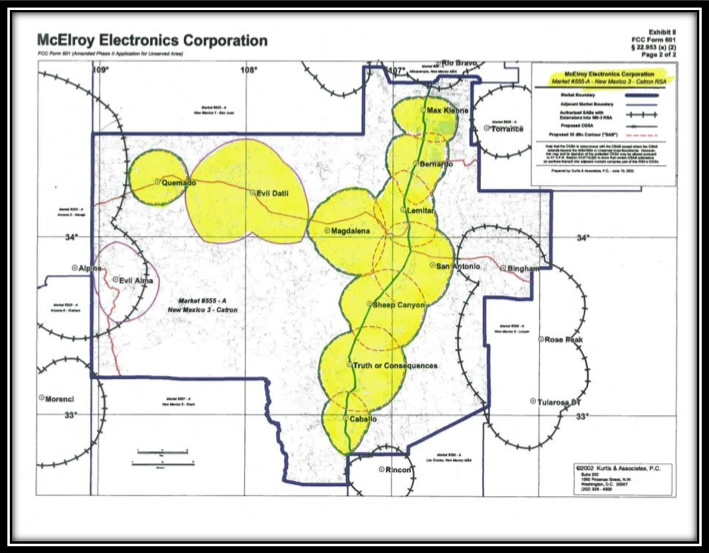
McElroy Electronics’ proposed coverage map for the New Mexico #3 market
On January 31, 2001, the DC Circuit affirmed the Commission’s decision to revoke Alee’s license for lack of candor, “essentially for the reasons stated by the Commission.” The Court stated that “substantial evidence supported the Commission’s determination that Alee Cellular Communications lacked candor in failing to reveal that it had an alien general partner and that there had been a change in its partnership structure.”
The Court found the evidence sufficient to support the Commission’s conclusion that Alee’s partners knowingly and intentionally withheld relevant information from the Commission, thus providing the Commission with ample basis to sanction Alee for its misconduct. The DC Circuit denied Alee’s petition for rehearing on April 5, 2001, and the Supreme Court denied Alee’s petition for writ of certiorari on October 9, 2001.
We were tipped off to the proceeding and along with several others filed an application to serve New Mexico #3, Las Cruces.
We settled years of litigation by selling our interest in this market to Alltel Communications.
Probably the most exotic unserved area that we uncovered was also…
The One That Got Away
In 2003 we filed to serve an unserved area about 68 miles west of Key West in the Florida Keys. The area delineated in yellow on the map is known as Dry Tortugas National Park.

Proposed coverage for Dry Tortugas National Park
The park preserves Fort Jefferson and the seven Dry Tortugas islands, the westernmost and most isolated of the Florida Keys. The park is noted for abundant sea life, tropical bird breeding grounds, colorful coral reefs, and legends of shipwrecks and sunken treasures. The park’s centerpiece is Fort Jefferson, a massive but unfinished coastal fortress.
The Curvature of the Earth Problem
The problem with this market was that it was too far from a land-based mobile telephone switching office (MTSO). The curvature of the earth was in the way. The only way we could communicate back to that switch was via satellite. The technology at the time would have been very costly and would result in a delay in voice communication.
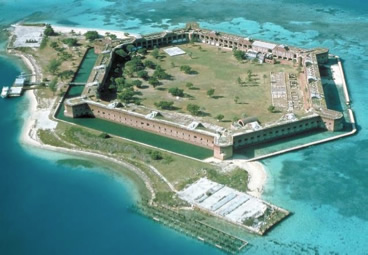 Fort Jefferson, Dry Tortugas National Park
Fort Jefferson, Dry Tortugas National ParkAlthough there were some 90,000 visitors a year to Fort Jefferson and the surrounding islands, we felt that that alone would not generate enough income to properly fund the project. Our hope was that the Park Service would use the cellular telephone system for their communication needs, making the venture more feasible.
We spoke to a lobbyist who suggested that funding for the project could be included in a spending bill. We weren’t comfortable with the idea because that is exactly what goes on all the time and why the country is where it is financially. It just wouldn’t be right.
The FCC was processing our application because there were no petitions to deny and no competing applications. In light of the technical difficulties and expense, we decided to withdraw our proposal to serve this unserved area.
Later we learned that the US Parks Department was issued satellite telephones, which would’ve rendered our hope to have them as the base customer moot.
C Block of the 700 MHz Band Markets in New Hampshire
In 2002, the FCC reallocated the Lower 700 MHz Band that had been allocated to television channels 52–59.
On September 18, 2002, the FCC completed an initial auction of 740 licenses in the Lower 700 MHz Band C and D blocks.
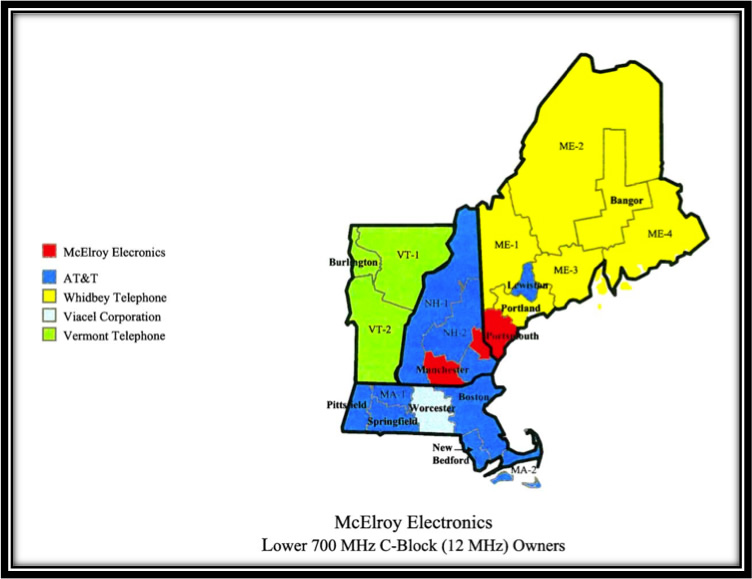
C Block of the 700 MHz Band Markets #133, Manchester–Nashua,
and Market #156, Portsmouth–Rochester–Dover
McElroy Electronics was high bidder for the licenses to serve market #133, Manchester–Nashua, and market #156, Station WPWV400, Portsmouth–Rochester–Dover, all in New Hampshire.
We were permitted to provide fixed, mobile, and broadcast services. It was possible to use this spectrum for mobile and other digital new broadcast operations, fixed and mobile wireless commercial services (including FDD- and TDD-based services), as well as fixed and mobile wireless uses for private, internal radio needs.
After careful consideration and a thorough market evaluation, we decided to sell these licenses to our old nemesis in Minneapolis, AT&T Services, Inc., on December 3, 2007.
Other Wireless Enterprises
McElroy also acquired 14 Multiple Address System (MAS) Licenses: Boston, Cincinnati, Cleveland; Minneapolis; Oklahoma City; Phoenix,; Seattle,; St. Louis, Pittsburgh,; Kansas City,; Las Vegas, ; Palm Springs, Santa Yanez (Santa Barbara), and San Diego
Deals and Financing
|
Some of the firms McElroy has negotiated
|
McElroy secured over $12 million
|






